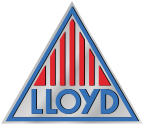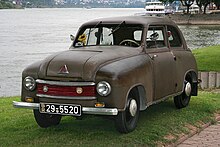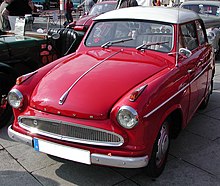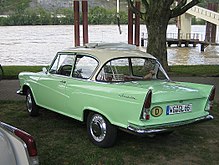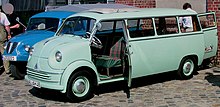Lloyd (car brand)
| Lloyd Motoren Werke GmbH
|
|
|---|---|
| legal form | GmbH |
| founding | 1905/1949 |
| resolution | 1961 |
| Reason for dissolution | insolvency |
| Seat | Bremen , Germany |
| Branch | Automotive industry |
| Website | www.lloyd-motoren.de |
Lloyd is the brand name of some car models from NAMAG (Norddeutsche Automobil- und Motoren-Actien-Gesellschaft) as well as Lloyd Motoren Werke GmbH , which later belonged to the Borgward Group and was founded on February 2, 1949 as Lloyd Maschinenfabrik GmbH .
historical overview
The beginnings up to the Second World War
The shipping company Norddeutscher Lloyd in Bremen was behind the Bremen car manufacturer NAMAG . At the beginning of the 20th century it had an electrical engineering department for the manufacture of railway engines. The engineer Sigmund Meyer (1873–1935) became its director in 1905 . From this department, the North German Automobil- und Motoren AG (NAMAG), headed by Meyer, emerged in 1906 , which manufactured passenger cars, taxis and commercial vehicles with electric wheel hub drives under license Kriéger under the brand names Lloyd and NAMAG . In 1914, Hansa-Automobil GmbH in Varel merged with NAMAG to form Hansa-Lloyd AG , based in Bremen. Products were mainly trucks , tractors and an almost unsaleable luxury automobile.
In mid-1929, the majority of shares in Hansa-Lloyd AG were taken over by Carl FW Borgward and Wilhelm Tecklenborg. Borgward and Tecklenborg had before the Great Depression - unlike many luxury car manufacturers - with their small commercial vehicles, e.g. B. the Blitzkarren , a three-wheeled vehicle with 2.2 HP, could still earn good money and founded the Hansa-Lloyd and Goliath-Werke Borgward & Tecklenborg oHG as a new company in 1931 . The name Lloyd was then no longer used by the group and its successors until 1950 - Tecklenborg left as a partner in 1937.
Re-establishment in 1949
In February 1949, Carl FWBorgward founded Lloyd Maschinenfabrik GmbH , which initially started operations on the Goliath-Werk GmbH site in Bremen- Hastedt . Half of the share capital of DM 100,000 was raised by Carl F. W. Borgward; 40,000 DM belonged to his wife Elisabeth and 10,000 DM was provided by the engineer Wilhelm Lathwesen. After an unsuccessful attempt to recreate looms, the young company manufactured electric vehicles (EL 3000) for the British occupying forces based on the Wehrmacht truck Borgward B 3000. Since Borgward had signed a three-year maintenance contract with the British for an annual lump sum and the vehicles hardly required any repairs, the deal made a good profit. In December 1950 Borgward and his wife, now sole shareholders, increased the capital to 800,000 DM. Taking inflation into account , this corresponds to a total of 2,088,815 euros today.
Under the traditional name of Lloyd , Lloyd Maschinenfabrik launched the small car LP 300 on the market in May 1950 , the body of which was made of plywood , which was covered with artificial leather , due to the then prevailing material shortage . His nickname: Leukoplast bomber. In the vernacular it was soon said: If you are not afraid of death, drive Lloyd . The car was powered by a 300 cm³, 10 hp two-stroke engine that was designed by the "Engineering and Construction Working Group" in Hude near Oldenburg. Former Auto Union employees from Central Germany worked there and the design therefore showed strong similarities with DKW engines from the pre-war period.
At the end of January 1951 the company was renamed Lloyd Motoren Werke GmbH and a little later the move to the new plant on a 200,000 m² site on Richard-Dunkel-Strasse in Bremen-Neustadt followed . The factory was expanded here until 1960. The Hall 4 of 1953/54 is since 2015 under Bremer listed .
Successful times: the 1950s
In 1953 the Lloyd 400 was presented with an engine enlarged to 400 cm³ (13 HP). While the 300 still had a rather clumsy body, the new model presented itself with more elegant lines, which were essentially retained until the end of production by the "small" Lloyd. The 400 series was also initially made with a plywood synthetic leather body. By October 1954, the wooden parts of the car built in Bremen-Neustadt were gradually replaced by steel. The performance of the economical motorized two-stroke Lloyd was low. In particular, the climbing ability on longer mountain slopes was in need of improvement. The vernacular, and here especially the drivers of more powerful cars, therefore sometimes rumored the saying "... standing on the mountain and howling!", Which was not entirely unjustified in view of the noise of the engine.
In 1955 the Lloyd LP 600 came out with a 600 cc four-stroke engine ; It was the most successful year in the company's history: Over 58,000 vehicles were built - Lloyd was third in the German registration statistics after VW and Opel and, at almost 70 percent, had the highest share of all cars in the Borgward Group. The LP 600 has been continuously improved. In the version with synchronized gear, crank windows and trunk that can be opened from the outside, it was called " Alexander " from 1957 . In 1958, a TS version with a new radiator grille was added to the range, which had 25 hp and was over 110 km / h. For reasons of the insurance classification, the power was later reduced to 23 hp, so that the top speed was only 107 km / h. A total of 176,524 600 units rolled off the production line, the last two vehicles were built in 1963 from remnants.
At the end of 1952, the company presented the LTK 500 for small businesses, a box van with a payload of 500 kg with a two-stroke engine and the typical Lloyd plywood body. At the same time, the car was offered as a six-seater minibus (LT 500/6). In 1953 came flatbed LT 500 pick-up to it. After the conversion to four-stroke engines in September 1955, the LTK 600 panel van and the LT 600/6 minibus were also manufactured with the 50 cm longer chassis of the flatbed truck on request from the end of 1956. The long version of the LT 600/6 was also exported in considerable numbers to the USA, where it was mainly used as a camping car.
Bankruptcy of the Borgward Group: The end of 1961
The Lloyd 900 "Arabella" , which came onto the market in 1959, played a considerable part in the bankruptcy of the Borgward group in 1961 (see also: Borgward bankruptcy ) : The development of the car with the new four-stroke engine and the construction of the modern production facilities required investments and depreciation amounting to DM 27 million, which after the collapse in sales for the vehicles of the Borgward group, especially in the USA at the end of 1960, could no longer be financed by the group. There were also start-up difficulties and costs for the recall campaigns. The Arabella was fully equipped, but calculated too tightly and only incurred losses per vehicle sold. Compared to the LP 600, the Arabella was a logical further development of the previously built small cars to close the gap to the larger Borgward cars, but with modern lines (e.g. with the then fashionable tail fins) it was still inexpensive and affordable for the smaller budget. However, teething problems arose at the start of production, which led to expensive product recalls and serious damage to the company's image: numerous gearbox damage occurred, and water got into the interior when it rained, which earned the car the nickname "Aquabella". A total of 47,042 of the Arabella were built; of which 1,493 vehicles were left until 1963 after the Borgwardwerke went bankrupt in 1961.
The "Lloyd Motoren Werke" continued to exist as a small company until 1989. In 1995 the managing director Karl-Heinz Bädeker had the company deleted from the commercial register. In addition to the supply of spare parts for the built Lloyd vehicles, the same function was assumed for the Borgward vehicles at the end of the 1960s. In addition, the two-cylinder two-stroke engine for the Lloyd passenger car was again manufactured from 1966. Over 8,000 copies were delivered to the USA and Canada alone , where they were primarily used as drive units for snowmobiles. The engine was also supplied as a boat engine.
Motorsport
Lloyd took part in numerous racing and rally events to demonstrate the reliability and robustness of the cars.
Lloyd won the "12 Hours of Hockenheim" in 1958 and 1959, a race in which different brands such as BMW, Fiat, Glas and NSU competed against each other with their 600 cc cars. Lloyd also took part in the Monte Carlo Rally in 1959 and 1960 with the “Alexander TS”. In 1960, the Lloyd cars were the only 600 cc class cars that made it to the finish line.
The Wiesbaden Lloyd dealer Karl-Heinz Schäufele built a streamlined racing car for record drives in 1954. Together with the drivers Adolf Brudes and Hubertus Ricker, he set 14 international records in the class up to 350 cm³ on the French Montlhéry circuit in May. The records of 5000 kilometers (average 112.10 km / h), 5000 miles and 24 hours are still unbroken today. In 1955, the car called the "White Mouse" was fitted with a 400 cm³ engine. Back in Montlhéry, the same three drivers set 13 international records in the up to 500 cm³ class.
Circumnavigation
The Bremen businessman Wolfram Block set off on a world tour in a Lloyd 600 on January 7, 1956. Block covered a total of 89,000 kilometers and returned to Bremen on May 28, 1957. He described his adventures in the book World Tour with 19 HP .
System of type designations
Up until the Alexander, the type designation for cars was made up of a combination of letters and a number:
- An L for L loyd
- One letter for the body shape, namely
- C for C oupé (at 300) and for C abriolimousine (at 400 and 600)
- K for K asten car (small vans without a rear side window)
- P for P ersonenwagen (saloon)
- S for S tationswagen (combi in current usage with rear side windows)
- A number corresponding to the rounded value of the displacement
The Lieferwagen- and bus models of the second letter was T for T ransporter.
The following number indicated the engine displacement rounded up to a full 100 cm³. Exceptions: The LP 250, which actually had a displacement of 250 cm³, and the LT 500, which was powered by the same 400 cm³ engine as the LP 400.
The Lloyd Alexander had this signature next to the designation 600, which was still to be found on the stern. According to this system, the Lloyd Arabella was also referred to as the Lloyd 900. With the Alexander TS, on the other hand, the designation as 600 was not in use and was not attached to the car.
Models and quantities
| model | body | construction time | engine | Displacement | kW (PS) | Corridors | km / h |
|---|---|---|---|---|---|---|---|
| Lloyd LP 300 | limousine | 1950-1952 | 2 cylinders; Two-stroke | 293 | 7.4 (10) | 3 | 75 |
| Lloyd LS 300 | Station wagon | 1951-1952 | 2 cylinders; Two-stroke | 293 | 7.4 (10) | 3 | 75 |
| Lloyd LK 300 | Box van | 1951-1952 | 2 cylinders; Two-stroke | 293 | 7.4 (10) | 3 | 75 |
| Lloyd LC 300 | Coupe | 1951-1952 | 2 cylinders; Two-stroke | 293 | 7.4 (10) | 3 | 75 |
| Lloyd LP 400 | limousine | 1953-1957 | 2 cylinders; Two-stroke | 386 | 9.6 (13) | 3 | 75 |
| Lloyd LS 400 | Station wagon | 1953-1957 | 2 cylinders; Two-stroke | 386 | 9.6 (13) | 3 | 75 |
| Lloyd LK 400 | Box van | 1953-1957 | 2 cylinders; Two-stroke | 386 | 9.6 (13) | 3 | 75 |
| Lloyd LC 400 | Convertible | 1953-1957 | 2 cylinders; Two-stroke | 386 | 9.6 (13) | 3 | 75 |
| Lloyd LT 500 | Delivery van / bus | 1953-1957 | 2 cylinders; Two-stroke | 386 | 9.6 (13) | 3 | 75 |
| Lloyd LP 250 and 250 V | limousine | 1956-1957 | 2 cylinders; Two-stroke | 250 | 8.1 (11) | 3 | 75 |
| Lloyd LP 600 | limousine | 1955-1961 | 2 cylinders; Four stroke | 596 | 14 (19) | 3 | 100 |
| Lloyd LS 600 | Station wagon | 1955-1961 | 2 cylinders; Four stroke | 596 | 14 (19) | 4th | 100 |
| Lloyd LK 600 | Box van | 1955-1961 | 2 cylinders; Four stroke | 596 | 14 (19) | 4th | 100 |
| Lloyd LC 600 | Convertible sedan | 1955-1958 | 2 cylinders; Four stroke | 596 | 14 (19) | 4th | 100 |
| Lloyd LP 600 / LS 600 Alexander | Limousine or station wagon | 1957-1961 | 2 cylinders; Four stroke | 596 | 14 (19) | 4th | 100 |
| Lloyd Alexander TS | Limousine or station wagon | 1958-1961 | 2 cylinders; Four stroke | 596 | 17 (23) | 4th | 107 |
| Lloyd LT 600 | Bus / delivery or flatbed truck | 1955-1961 | 2 cylinders; Four stroke | 596 | 14 (19) | 4th | 85 |
| Lloyd Theodor | LT 600 special body camper | 1955-1961 | 2 cylinders; Four stroke | 596 | 14 (19) | 4th | 85 |
| Lloyd 900 Arabella | limousine | 1959-1961 | 4 cylinders; Four stroke | 897 | 28 (38) 1960–1963 also 25 (34) |
4th | 120 |
| Lloyd 900 Arabella de Luxe | limousine | 1960-1961 | 4 cylinders; Four stroke | 897 | 33 (45) | 4th | 133 |
| model | number of pieces |
|---|---|
| Lloyd 300 LP, LS and LC | 18,087 |
| Lloyd 400 LP, LS and LC | 109,878 |
| Lloyd 250 and 250 V | 3,768 |
| Lloyd 600 LP, LS and LC, Alexander and Alexander TS | 176,524 |
| Lloyd Arabella and Arabella de Luxe | 47,549 |
Timelines
Vehicles 1919–1945
| Timeline of the Hansa-Lloyd, Hansa , Goliath and Borgward models from 1919 to 1945 | |||||||||||||||||||||||||||||||||||||||||||||||||||||||
|---|---|---|---|---|---|---|---|---|---|---|---|---|---|---|---|---|---|---|---|---|---|---|---|---|---|---|---|---|---|---|---|---|---|---|---|---|---|---|---|---|---|---|---|---|---|---|---|---|---|---|---|---|---|---|---|
| Type |
Hansa-Lloyd Werke AG and Fahrzeugwerke Borgward & Co. and from 1928 Goliath-Werke Borgward & Co. as two companies |
connected |
Hansa-Lloyd and Goliath-Werke Borgward & Tecklenborg oHG from 1936: Hansa-Lloyd and Goliath-Werke AG |
Hansa-Lloyd-Goliath works Carl F. W. Borgward and Carl F. W. Borgward, automobile and engine works with Carl Borgward as sole owner |
|||||||||||||||||||||||||||||||||||||||||||||||||||
| 1910s | 1920s | 1930s | 1940s | ||||||||||||||||||||||||||||||||||||||||||||||||||||
| 9 | 0 | 1 | 2 | 3 | 4th | 5 | 6th | 7th | 8th | 9 | 0 | 1 | 2 | 3 | 4th | 5 | 6th | 7th | 8th | 9 | 0 | 1 | 2 | 3 | 4th | 5 | |||||||||||||||||||||||||||||
| Microcar | 3-wheeled | pioneer | |||||||||||||||||||||||||||||||||||||||||||||||||||||
| Small car | 400 | 500 | |||||||||||||||||||||||||||||||||||||||||||||||||||||
| Middle class | Type p | 1100 / 1700 | |||||||||||||||||||||||||||||||||||||||||||||||||||||
| 1700 sports | |||||||||||||||||||||||||||||||||||||||||||||||||||||||
| 2000 | 2000/2300 | ||||||||||||||||||||||||||||||||||||||||||||||||||||||
| Upper class | Matador | Consul / luxury | senator | 3500 | |||||||||||||||||||||||||||||||||||||||||||||||||||
| Type A 6 | Type A 8 | ||||||||||||||||||||||||||||||||||||||||||||||||||||||
| Treff-Aß | Trump ace | ||||||||||||||||||||||||||||||||||||||||||||||||||||||
| Delivery vans / vans / minibuses | 3-wheeled | Lightning carts | |||||||||||||||||||||||||||||||||||||||||||||||||||||
| Rapid / Standard | F 200 & F 400 |
FW 200 FW 400 |
|||||||||||||||||||||||||||||||||||||||||||||||||||||
| 4-wheeled | K1 | Express (1929) | L500 | L600 | |||||||||||||||||||||||||||||||||||||||||||||||||||
| Atlas | Atlas | record | |||||||||||||||||||||||||||||||||||||||||||||||||||||
| Trucks and buses | 1 - 3 t payload | Superior | express | express | L 1400/1 t | ||||||||||||||||||||||||||||||||||||||||||||||||||
| Express (L 1.5) | Columbus | Columbus | L 2000 | ||||||||||||||||||||||||||||||||||||||||||||||||||||
| Bremen I & II (SL 1.5) | III | IV | |||||||||||||||||||||||||||||||||||||||||||||||||||||
| 2 - 4 t payload | Europe I & II (SL 2) | III | IV | Europe V | |||||||||||||||||||||||||||||||||||||||||||||||||||
| 3t | Type 3t GW | B 3000 | |||||||||||||||||||||||||||||||||||||||||||||||||||||
| 3 - 5 t payload | Mercury (L III) | II | III | IV | 4.5 - 5 t | 5 t | |||||||||||||||||||||||||||||||||||||||||||||||||
| Roland | |||||||||||||||||||||||||||||||||||||||||||||||||||||||
|
|
|||||||||||||||||||||||||||||||||||||||||||||||||||||||
Vehicles 1947–1963
| Timeline of Borgward , Lloyd , Goliath and Hansa models from 1947 to 1963 | |||||||||||||||||||||||||||||||||||
|---|---|---|---|---|---|---|---|---|---|---|---|---|---|---|---|---|---|---|---|---|---|---|---|---|---|---|---|---|---|---|---|---|---|---|---|
| Type | Foundation of three individual companies (Borgward, Lloyd, Goliath) | Bundling in Borgward Holding | insolvency | ||||||||||||||||||||||||||||||||
| 1940s | 1950s | 1960s | |||||||||||||||||||||||||||||||||
| 7th | 8th | 9 | 0 | 1 | 2 | 3 | 4th | 5 | 6th | 7th | 8th | 9 | 0 | 1 | 2 | 3 | |||||||||||||||||||
| Small car | Lloyd 250 | ||||||||||||||||||||||||||||||||||
| Lloyd 300 | Lloyd 400 | ||||||||||||||||||||||||||||||||||
| Lloyd 600 / Lloyd Alexander | |||||||||||||||||||||||||||||||||||
| Lower middle class | Lloyd Arabella | ||||||||||||||||||||||||||||||||||
| Borgward Arabella de Luxe | |||||||||||||||||||||||||||||||||||
| Goliath GP 700 | Goliath GP 900 | Goliath GP 1100 | Hansa 1100 | ||||||||||||||||||||||||||||||||
| Middle class | Borgward Hansa 1500 | Borgward Hansa 1800 | Borgward Isabella | ||||||||||||||||||||||||||||||||
| Upper class | Borgward Hansa 2400 Sport | ||||||||||||||||||||||||||||||||||
| Borgward Hansa 2400 Pullman | Borgward P 100 | ||||||||||||||||||||||||||||||||||
| Sports car | Goliath GP 700 E. | Borgward Isabella Coupe | |||||||||||||||||||||||||||||||||
| Off-road vehicle | Goliath type 31 | Goliath hunting car type 34 | |||||||||||||||||||||||||||||||||
| Borgward B 2000 A / O Kübelwagen | of Bussing built further | ||||||||||||||||||||||||||||||||||
| Delivery vans / vans | 3-wheeled | Goliath GD 750 | Goliath Goli | ||||||||||||||||||||||||||||||||
| 4-wheeled | Lloyd LT 500 | Lloyd LT 600 | |||||||||||||||||||||||||||||||||
| Goliath GV 800 | Goliath Express | ||||||||||||||||||||||||||||||||||
| Truck / minibus | 1–2 t payload | Borgward B 1000 | Borgward B 1250 | Borgward B 1500 | Borgward B 1500 | Borgward B511 | |||||||||||||||||||||||||||||
| Borgward B 1500 F. | Borgward B611 | ||||||||||||||||||||||||||||||||||
| 2–3 t payload | Borgward B 2000 | ||||||||||||||||||||||||||||||||||
| Borgward B 2500 | Borgward B 522 | ||||||||||||||||||||||||||||||||||
| Borgward B 2500 F (chassis for buses) | Borgward B 622 | ||||||||||||||||||||||||||||||||||
| 3–6 t payload | Borgward B 3000 | Borgward B 4000 | Borgward B 533 | ||||||||||||||||||||||||||||||||
| Borgward B 544 | |||||||||||||||||||||||||||||||||||
| Borgward B 4500 | Borgward B 555 | ||||||||||||||||||||||||||||||||||
| Borgward B655 | |||||||||||||||||||||||||||||||||||
|
|
|||||||||||||||||||||||||||||||||||
Companies
| Borgward group until bankruptcy in 1961 | |||||||||||||||||||||||||||||||||||||||||||||||||||||||||||||||
|---|---|---|---|---|---|---|---|---|---|---|---|---|---|---|---|---|---|---|---|---|---|---|---|---|---|---|---|---|---|---|---|---|---|---|---|---|---|---|---|---|---|---|---|---|---|---|---|---|---|---|---|---|---|---|---|---|---|---|---|---|---|---|---|
| Brand / company | 1900s | 1910s | 1920s | 1930s | 1940s | 1950s | 1960s | ||||||||||||||||||||||||||||||||||||||||||||||||||||||||
| 0 | 1 | 2 | 3 | 4th | 5 | 6th | 7th | 8th | 9 | 0 | 1 | 2 | 3 | 4th | 5 | 6th | 7th | 8th | 9 | 0 | 1 | 2 | 3 | 4th | 5 | 6th | 7th | 8th | 9 | 0 | 1 | 2 | 3 | 4th | 5 | 6th | 7th | 8th | 9 | 0 | 1 | 2 | 3 | 4th | 5 | 6th | 7th | 8th | 9 | 0 | 1 | 2 | 3 | 4th | 5 | 6th | 7th | 8th | 9 | 0 | 1 | 2 | |
| Borgward | Bremer Kühlerfabrik Borgward & Co | Fahrzeugwerke Borgward & Co. "Goliath" as a brand |
Goliath works Borgward & Co. |
Hansa-Lloyd and Goliath-Werke Borgward & Tecklenborg |
Hansa-Lloyd-Goliath Werke AG | Carl FW Borgward | Carl FW Borgward GmbH | Dr. Carl F. W. Borgward Holding | |||||||||||||||||||||||||||||||||||||||||||||||||||||||
| Goliath | Goliath-Werk GmbH "Goliath" and "Hansa" as brands |
Dr. Carl F. W. Borgward Holding | |||||||||||||||||||||||||||||||||||||||||||||||||||||||||||||
| Hansa | Hansa Automobil Gesellschaft | Hansa-Lloyd AG | Cooperation in the Association of German Automobile Manufacturers (GDA) |
Majority in Borgward and Tecklenborg |
|||||||||||||||||||||||||||||||||||||||||||||||||||||||||||
| Lloyd | Norddeutsche Automobil und Motoren AG (NAMAG), "Lloyd" as a brand |
Lloyd Maschinenfabrik GmbH | Lloyd Motoren Werke GmbH | ||||||||||||||||||||||||||||||||||||||||||||||||||||||||||||
| NAG | AAG | New Automobile GmbH | National Automobile Corporation | Cooperation in the Association of German Automobile Manufacturers (GDA) |
to Büssing AG as "Büssing-NAG" |
||||||||||||||||||||||||||||||||||||||||||||||||||||||||||
| Brennabor | Brennabor works | ||||||||||||||||||||||||||||||||||||||||||||||||||||||||||||||
|
|
|||||||||||||||||||||||||||||||||||||||||||||||||||||||||||||||
literature
- Wolfram Block: World tour with 19 hp - in Lloyd on a long journey. edition garage 2cv, Lüdenscheid 2006, ISBN 3-9809082-3-2
- Birgid Hanke : Carl FW Borgward - entrepreneur and car designer . Delius-Klasing, Bielefeld 2010, ISBN 978-3-7688-3145-1
- Engelbert Hartwig: Did Isabella Have to Die ?: The tragedy of the Borgward group. Verlag Peter Kurz, Bremen 2001, ISBN 3-927485-29-2
- Peter Kurz: Drive better, drive Borgward 1958 , Borgward Chronicle. Verlag Peter Kurz, Bremen 2014, ISBN 978-3-927485-58-7
- Peter Kurz: Lloyd - the car for you. Delius-Klasing Verlag, Bielefeld 2006, ISBN 3-7688-1725-3
- Peter Kurz: Lloyd Werk · Industrial Park · Garages - 1941 until today. Verlag Peter Kurz, Bremen 2015, ISBN 978-3-927485-07-5 .
- Peter Kurz: Searching for traces: Autoindustrie Bremen Borgward - Goliath - Lloyd. Verlag Peter Kurz, Bremen 2003, ISBN 978-3-927485-26-6
- Peter Kurz: Delivery vans and trucks from Bremen Commercial vehicles from Borgward, Goliath, Lloyd, Hanomag and Mercedes. Verlag Peter Kurz, Bremen 2007, ISBN 978-3-927485-26-6
- Kurz, Neumann: 100 Years of Automobile Manufacturing in Bremen - The Hansa-Lloyd and Borgward Era 1906 to 1961. Verlag Peter kurz, Bremen 2007, ISBN 978-3-927485-51-8
- Peter Kurz: Prototypes and small series vehicles from the Borgward, Goliath and Lloyd plants . Verlag Peter Kurz, Bremen 2008, ISBN 978-3-927485-53-2
- Christian Steiger: Borgward - Goliath - Lloyd, passenger cars 1931–1970. Motorbuch Verlag, Stuttgart 1999, ISBN 3-613-01946-9
Web links
Clubs
- Lloyd friends
- Lloyd friends IG
- lloyd-motoren.de
- The-English-Lloyd-Home-Page
- Carl FW Borgward interest group
information
- Technical pages
- Virtual Borgward Museum
- Würnschimmel Collection, Vienna
- Borgward Collection, Bremen (former Kröll Collection)
Individual evidence
- ^ Monument database of the LfD
- ↑ Hans W. Mayer: Lloyd - from the electric vehicle to the Arabella . 1st edition. Motorbuch Verlag, Stuttgart 1989, p. 181.
- ↑ Hans W. Mayer: Lloyd - from the electric vehicle to the Arabella . 1st edition. Motorbuch Verlag, Stuttgart 1989, p. 75.
